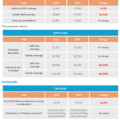
Many employee benefits are subject to annual dollar limits that are periodically updated for inflation by the IRS. The IRS typically announces the dollar limits that will apply for the next calendar year well in advance of the beginning of that year. This gives employers time to update their plan designs and make sure that their plan administration will be consistent with the new limits.
The following commonly offered employee benefits are subject to inflation-adjusted dollar limits:
- High deductible health plans (HDHPs)
- Health savings accounts (HSAs)
- Health flexible spending accounts (FSAs)
- 401(k) plans
- Transportation fringe benefit plans
Although some of the limits will remain the same, many of the limits will increase for 2018.
Increased Limits
- HDHP minimum deductible
- Self-only: $1,350 (up $50)
- Family: $2,700 (up $100)
- HDHP out-of-pocket maximum (OOPM)
- Self-only: $6,650 (up $100)
- Family: $13,300 (up $200)
- HSA contribution limit
- Self-only: $3,450 (up $50)
- Family: $6,900 (up $150)
- OOPM on essential health benefits (non-grandfathered plans)
- Self-only: $7,350 (up $200)
- Family: $14,700 (up $400)
- Health FSA
- $2,650 (up $50)
- Transportation fringe benefits (monthly limits)
- Transit pass and vanpooling (combined): $260 (up $5)
- Parking: $260 (up $5)
- 401(k) contributions
- Employee elective deferrals: $18,500 (up $500)
Unchanged Limits
- HSA catch-up contributions*: $1,000
- Dependent care FSA*
- Tax exclusion: $5,000 ($2,500 if married and filing taxes separately)
- 401(k) catch-up contributions: $6,000
*Not subject to annual adjustment for inflation





